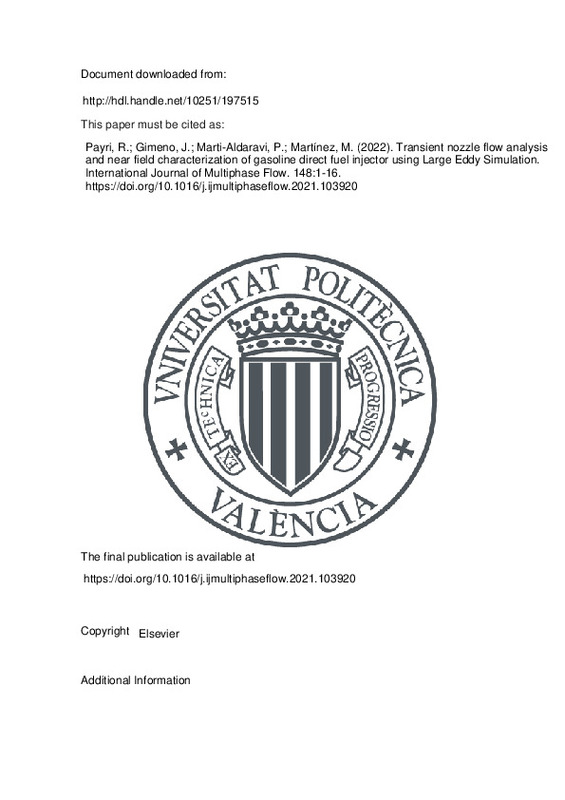JavaScript is disabled for your browser. Some features of this site may not work without it.
Buscar en RiuNet
Listar
Mi cuenta
Estadísticas
Ayuda RiuNet
Admin. UPV
Transient nozzle flow analysis and near field characterization of gasoline direct fuel injector using Large Eddy Simulation
Mostrar el registro sencillo del ítem
Ficheros en el ítem
| dc.contributor.author | Payri, Raul
|
es_ES |
| dc.contributor.author | Gimeno, Jaime
|
es_ES |
| dc.contributor.author | Marti-Aldaravi, Pedro
|
es_ES |
| dc.contributor.author | Martínez, María
|
es_ES |
| dc.date.accessioned | 2023-10-03T18:01:42Z | |
| dc.date.available | 2023-10-03T18:01:42Z | |
| dc.date.issued | 2022-03 | es_ES |
| dc.identifier.issn | 0301-9322 | es_ES |
| dc.identifier.uri | http://hdl.handle.net/10251/197515 | |
| dc.description.abstract | [EN] Injection duration in spark ignition engines is typically very short. Thus, understanding transient effects of the Gasoline Direct injection (GDi) process plays a major role in the analysis of the mixture formation and so combustion efficiency in this type of engines. Focusing on the opening and closing phases when the needle is moving up and downwards, there still are some uncertainties. For instance, the effect of wobble may lead to uneven distribution of fuel among the holes, and therefore differences in spray formation and even plume to-plume interactions. Other factors that may affect the shape of the rate of injection and so the mixture formation are the time evolution of the upstream pressure (related to the injector dynamics) together with the detailed geometry of the needle and its seat. Experimentally addressing these issues nowadays remains challenging, if not impossible, so Computational Fluid Dynamics (CFD) are used to study this phase of the injection process. Large Eddy Simulations (LES) are selected to account for the effects of turbulence. Volume of-Fluid (VOF) approach is used, not only to analyze the flow inside the nozzle, but also the first 2-5 mm of the spray. Homogeneous Relaxation Model (HRM) is employed to consider the mass exchange between liquid and vapor phases of the fuel inside the nozzle, if necessary. The Spray G operating condition of Engine Combustion Network (ECN) is used in this analysis. Statistics of several realizations are performed in order to extract significant conclusions. Results are validated against experimental data, and show the effects of the turbulence in the spray development. A strong interaction between jets, especially in the transitory phases of the simulation (opening and closing), is observed. Spray parameters, after averaging the different realizations, also accurately match the experimental results and previous simulations reported in the literature. One of these precisely captured effects is the deviation of the spray from the geometric axis of the orifice. | es_ES |
| dc.description.sponsorship | This research was funded by Generalitat Valenciana through project reference AICO/2020/208 titled "Nuevos conceptos en inyeccion de gasolina (NCIG)''. Additionally, authors would like to thank the "Fundacion del Centro de Supercomputacion de Castilla.. Leon'' (FCSCL) and "ACT now HPC Cloud Cluster'' for allowing the use of their clusters to perform part of the simulations carried out in this work. Also to Abian Bautista and Javier Varea for their help in the analysis. Finally mention that the Ph.D. student Maria Martinez has been funded by a grant from the Government of Generalitat Valenciana with reference ACIF/2018/118 and financial support from The European Union. | es_ES |
| dc.language | Inglés | es_ES |
| dc.publisher | Elsevier | es_ES |
| dc.relation.ispartof | International Journal of Multiphase Flow | es_ES |
| dc.rights | Reconocimiento - No comercial - Sin obra derivada (by-nc-nd) | es_ES |
| dc.subject | GDi | es_ES |
| dc.subject | CFD | es_ES |
| dc.subject | Nozzle flow | es_ES |
| dc.subject | Transient | es_ES |
| dc.subject | LES | es_ES |
| dc.subject.classification | MAQUINAS Y MOTORES TERMICOS | es_ES |
| dc.subject.classification | INGENIERIA AEROESPACIAL | es_ES |
| dc.title | Transient nozzle flow analysis and near field characterization of gasoline direct fuel injector using Large Eddy Simulation | es_ES |
| dc.type | Artículo | es_ES |
| dc.identifier.doi | 10.1016/j.ijmultiphaseflow.2021.103920 | es_ES |
| dc.relation.projectID | info:eu-repo/grantAgreement/GVA//ACIF%2F2018%2F118//AYUDA PREDOCTORAL GVA-MARTINEZ GARCIA. PROYECTO: COMPUTATIONAL STUDY OF THE INJECTION PROCESS IN GASOLINE DIRECT INJECTION (GDi) engines/ | es_ES |
| dc.relation.projectID | info:eu-repo/grantAgreement/GVA//AICO%2F2020%2F208//Nuevos conceptos en inyeccion de gasolina (NCIG)/ | es_ES |
| dc.rights.accessRights | Abierto | es_ES |
| dc.contributor.affiliation | Universitat Politècnica de València. Escuela Técnica Superior de Ingenieros Industriales - Escola Tècnica Superior d'Enginyers Industrials | es_ES |
| dc.contributor.affiliation | Universitat Politècnica de València. Escuela Técnica Superior de Ingeniería del Diseño - Escola Tècnica Superior d'Enginyeria del Disseny | es_ES |
| dc.description.bibliographicCitation | Payri, R.; Gimeno, J.; Marti-Aldaravi, P.; Martínez, M. (2022). Transient nozzle flow analysis and near field characterization of gasoline direct fuel injector using Large Eddy Simulation. International Journal of Multiphase Flow. 148:1-16. https://doi.org/10.1016/j.ijmultiphaseflow.2021.103920 | es_ES |
| dc.description.accrualMethod | S | es_ES |
| dc.relation.publisherversion | https://doi.org/10.1016/j.ijmultiphaseflow.2021.103920 | es_ES |
| dc.description.upvformatpinicio | 1 | es_ES |
| dc.description.upvformatpfin | 16 | es_ES |
| dc.type.version | info:eu-repo/semantics/publishedVersion | es_ES |
| dc.description.volume | 148 | es_ES |
| dc.relation.pasarela | S\471960 | es_ES |
| dc.contributor.funder | Generalitat Valenciana | es_ES |







![[Cerrado]](/themes/UPV/images/candado.png)

